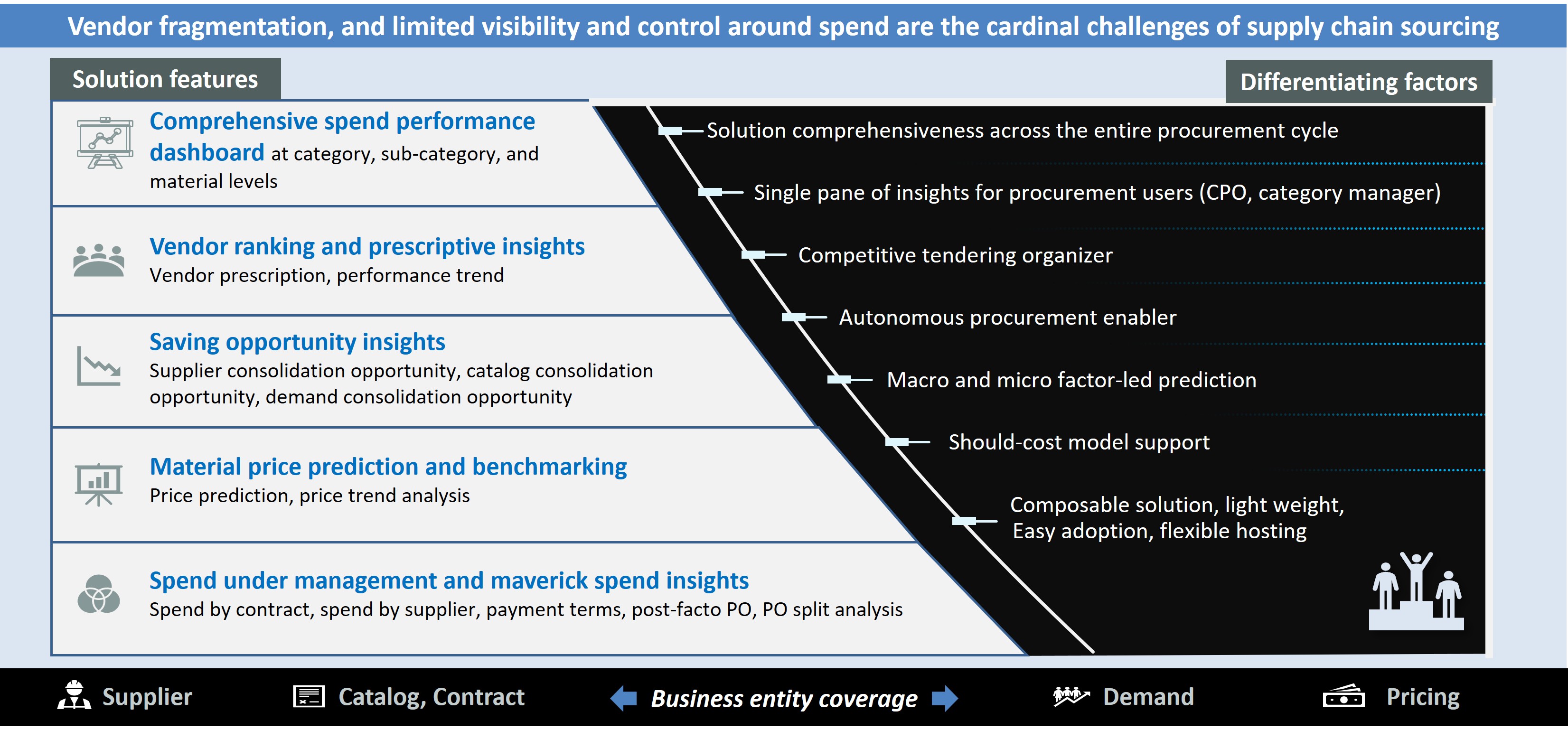Service
Highlights
- CXOs today are shifting gears, prioritizing profitability over aggressive growth.
- Procurement, owing to its significant contribution to operational costs, has emerged as a critical lever of cost optimization.
- Spend analytics driven by technologies like generative artificial intelligence (GenAI) can drive cost optimization by providing a granular view of spending.
Recalibrating priorities
In the face of macroeconomic headwinds—rising inflation, supply chain disruptions, and unending geopolitical strife—business leaders around the globe are being compelled to recalibrate their strategic priorities.
Amid the volatility, CXOs are shifting gears, prioritizing financial sustainability and profitability over aggressive growth.
The climate of uncertainty has compelled organizations to scrutinize every facet of their operations. Procurement, owing to its significant contribution to operational costs, has emerged as a critical lever of cost optimization. Therefore, even marginal improvements in procurement efficiency can lead to substantial cost savings and enhanced profitability.
However, as organizations expand and their operations start to sprawl across territories, managing procurement spend becomes exponentially difficult. Therefore, tracking where and how costs are generated is more important than ever, and analytics are becoming indispensable for tackling these challenges.
A new era of spend analytics
Traditional analytics solutions are saddled with severe limitations that restrict their ability to meet the predictive and prescriptive needs of the modern enterprises looking to build resilience to deal with constant change.
The scope of conventional spend analytics is predominantly ‘descriptive’ and ’diagnostic’ in nature ie, they majorly focus on analyzing and providing insights based on historic data but rarely provide forward-looking insights. They are also focused on processing and working with mostly structured data.
But the advent of avant-garde technologies like artificial intelligence (AI), generative AI (GenAI), and agentic AI have disrupted spend analytics. These advanced technologies, when working in harmony, enable enterprises to work with both structured and unstructured data, driving the shift towards ‘predictive’ and ’prescriptive’ spend analytics. This enables organizations to manage risk, predict disruptions, and turn them into a strategic advantage.
Focus areas
Future-ready spend analytics refers to intelligent, adaptive systems that help organizations to be prepared for any disruption.
Such systems (see Figure 1):
- Continuously learn and evolve using data
- Integrate structured and unstructured data sources
- Offer real-time, actionable insights
- Automatically act or recommend actions aligned with strategic procurement goals
Procurement is a vast function involving several moving parts. Enterprises must establish focus areas where technology can drive cost optimization through a granular view of spending. Some of these areas include:
Supplier selection
Choosing the right suppliers is critical for any organization. It’s not only about cost optimization but building strong supplier relationships that create resilience in the long term. Applications powered by GenAI and agentic AI can analyze unstructured data sources to generate a 360° view of suppliers based on factors like performance, reputation, and compliance records and prescribe them to the enterprise. Agentic AI will go a step further by autonomously initiating supplier outreach and negotiating contracts.
Tail spend management
Ad-hoc spending and uncategorized purchases, which are high in volume (about 80% of overall volume) but low in value (about 20 % of overall spend), are often neglected. However, when profitability and cost reduction become priority, control on indirect spend areas such as tail spend can lead to significant savings. By leveraging GenAI and agentic AI, enterprises can significantly reduce tail spend by bringing visibility, control, and automation to low-value, high-frequency purchases. GenAI analyzes historical spend data to identify and provide insights into fragmented, non-compliant purchases. It facilitates the standardization of buying patterns and suggests preferred suppliers or contracts.
Product classification
AI and ML powered systems can categorize products into segments like ‘strategic’, ‘leverage’, ‘bottleneck’ or ‘routine’ by analyzing data pertaining to spend, frequency of purchase, number of suppliers, and price. Subsequently, through ‘cataloging’ or ’contracting’, ’routine’, and ’bottleneck’ products are matched accurately with the best vendors, facilitating direct savings through price hedging, supplemented by indirect savings resulting from truncating the end-to-end bidding process.
Should-cost model
As the name suggests, ’should-cost’ model allows organizations to determine the true price of a product, especially the ’strategic’ and ’leverage’ ones. The quintessential models leveraged by conventional spend analytics are biased in the sense that they are of linear ilk. Analytics tools powered by AI and GenAI, on the other hand, are purpose-built for successfully capturing the non-linearity of the real-world and associated complexities. By predicting future price fluctuations, they can prevent possible disruptions by predicting macro-economic uncertainties, and supply chain disruptions.
Pricing
It’s a standard supply chain practice to measure price trends of individual product against the product subcategory to which it belongs to obtain insights on direct savings opportunities. However, this doesn’t always provide the right picture because the price of individual products in a product sub-category might vary widely, leading to biased results. To mitigate the issue, agentic AI-powered systems can be leveraged to create ’price clusters’ automatically within the product sub-categories. These clusters are nothing but further grouping of products based on the proximity of their prices. When price movement of the products is compared with that of the price cluster, accurate direct savings insights are obtained. These insights can be aggregated at a product category, or sub-category, or organizational level to obtain the right insights.
What lies ahead
As we crystal gaze the future of spend analytics for procurement, it must be guised as the interactive interface of future-ready spend analytics.
Founded upon predictive and prescriptive insights, it:
- Evinces information like ‘who are my top suppliers?’, ‘what should be the true price of the material?’, ‘is there a catalog opportunity for the material?’, ‘what are my direct and indirect savings opportunity for the product category?’ at the touch of a button
- Allows users to get down to the brass tacks of end-to-end procurement spends
- Enables users to emulate future scenarios and prescribes solutions to turn possible disruptions into a competitive advantage
- Provides a well-rounded, holistic outlook across the organization’s procurement cycle

